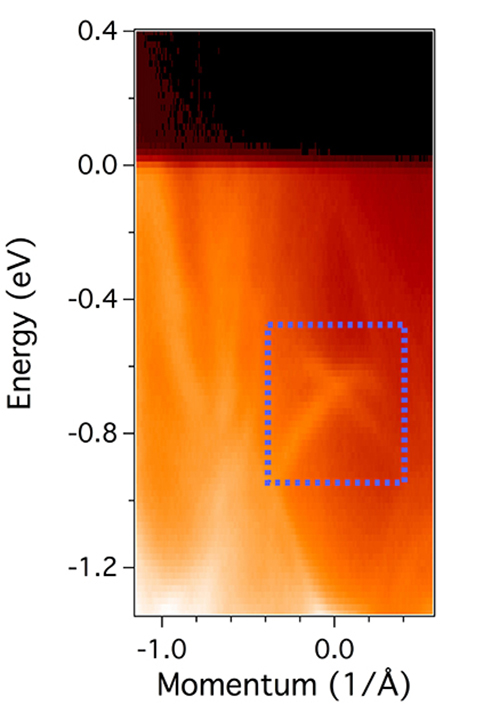
The box marks the spot of the Dirac point of surface states: The surface electronic structure interrogates the relationship between superconductivity and topology. Scientists observed spin-polarized surface states in the noncentrosymmetric superconductor bismuth palladium (BiPd). The observation provides insightful information to guide future searches for topological superconductors, which are promising architectures for quantum information and computation technologies. Image: The image was published and distributed under a Creative Commons CC-BY license. We have permission from Nature Communications to reuse this image without further permission from Nature Publishing Group.
When it comes to entirely new, faster, more powerful computers, Majorana fermions may be the answer. These hypothetical particles can do a better job than conventional quantum bits (qubits) of light or matter. Why? Because of the spooky way Majorana fermions interact with each other at a distance. When two fermions interact, they usually dissipate energy, whereas two Majoranas are entangled and preserve the quantum state. But where to find these unique particles? Scientists observed a unique state on the surface of a superconducting material made of equal parts bismuth and palladium. While it didn’t host the long sought-after hypothetical Majorana fermions, it will stimulate further search for materials that do, paving a potential pathway for new computer architectures.
The study provides vital insight into the origin of superconductivity and the detection of Majoranas at Dirac points on the surface compared to the bulk. In turn, the results may help, one day, identify Majorana fermions. These particles could change how we design quantum computers.
Given their considerable application potential, from quantum computing to information technologies, noncentrosymmetric (NCS) superconductors have attracted significant experimental and theoretical interest. In the presence of spin-orbit coupling, these materials are potential candidates for topological superconductivity that host protected Majorana fermion surface states. However, evidence for topological superconducting surface states, and spin-orbit coupling, in NCS materials is scarce. This work has revealed the existence of spin-polarized surface states in the NCS material BiPd, providing unique insight into the electronic structure and identifying a potential pathway to the elusive Marjorana fermion surface states. Scientists conducted a systematic high-resolution angle-resolved photoemission spectroscopy (ARPES) and spin-resolved ARPES study of electronic and spin properties in the normal state of this superconductor. The detailed photon energy, temperature-dependent and spin-resolved ARPES measurements, complemented by first-principles electronic structure calculations, demonstrated the presence of surface states at higher binding energy with the location of the Dirac point at around 700?meV below the Fermi level. While these results negate the existence of topological superconductivity in BiPd, they provide critical information for identifying, and in time controlling through electrical gating, topologically protected surface states in NCS materials that could create a new class of quantum devices based on Majorana fermions.




